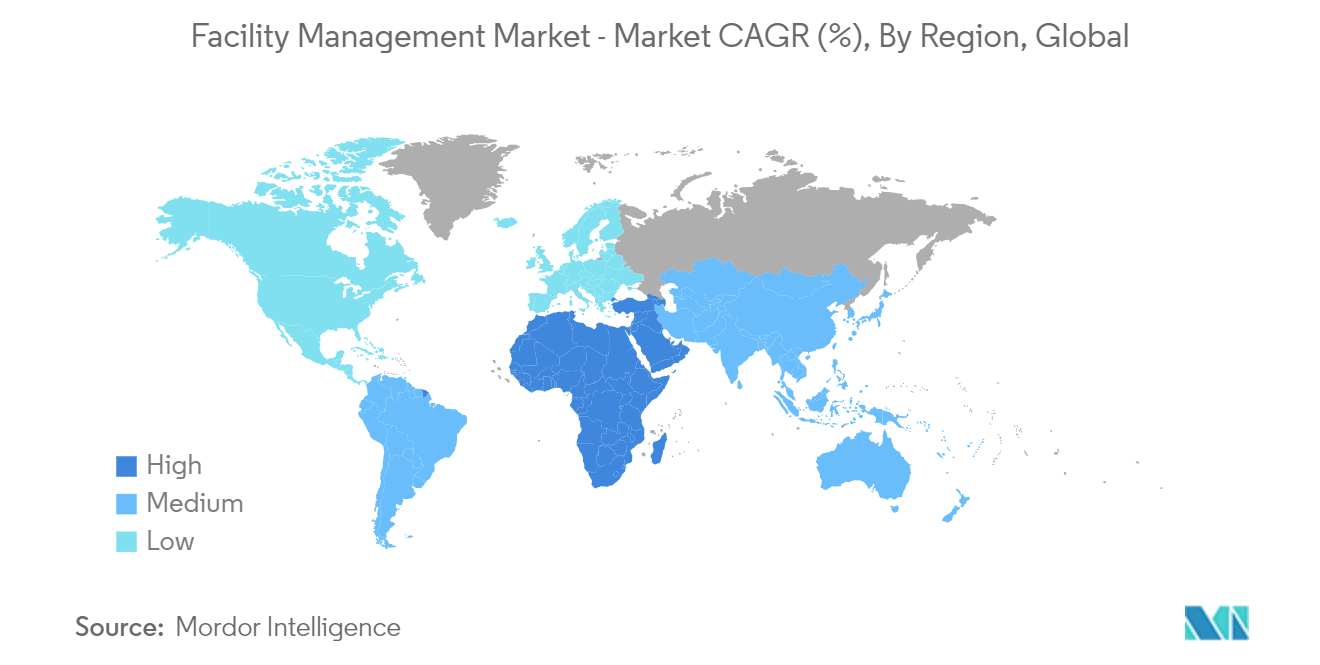Market Trends of Facility Management Industry
Increasing Focus on Core Competencies to Drive Market Growth
- The significance of focusing resources, time, and expertise on core competencies is becoming increasingly evident to organizations. Core competencies are specific abilities that offer businesses a competitive edge in their specialized industries. Organizations may concentrate on their core business operations by contracting with outside service providers for facility management functions, including product development, sales, marketing, and innovation. This strategic focus allows organizations to allocate their resources effectively and achieve higher levels of efficiency and productivity.
- In addition, facility management providers are expanding their service offerings beyond traditional tasks to provide value-added services that directly support the organization's core competencies. This may include strategic facility planning, space optimization, workplace design consulting, sustainability initiatives, and energy management programs. Companies are expected to support the organization's overall business goals, providing significant cost savings and improving the user experience by providing these value-added services.
- Further, facility management providers are recognizing the importance of employee experience and its impact on productivity, engagement, and talent retention. As organizations focus on their core competencies, facility management providers would adapt their services to create environments promoting employee well-being, collaboration, and innovation. This may involve implementing ergonomic design principles, integrating technology for seamless workplace experiences, providing amenities and wellness programs, and ensuring a safe and comfortable work environment.
- According to a Cleaning & Maintenance Management (CMM) survey, in 2022, around 24% of facility management personnel in the United States replied to the question by claiming that they manage college or university buildings. Industrial environments, such as manufacturing and warehousing, were recorded as the least-managed facilities. The survey findings indicate that many facility management personnel in the United States are involved in managing college or university buildings. Such institutions are expected to benefit from specialized skills, affordable solutions, and current standards in the industry by collaborating with facility management providers to ensure optimal facility operations and foster an environment that is favorable to study and research.
- Additionally, facility management service providers are adapting their products to reflect these changes as firms work to streamline their operations, integrate technology, supply value-added services, and build sustainable environments. Organizations are anticipated to get specialized knowledge, tailored solutions, and innovative techniques that support their overall success by concentrating on their core strengths and strategic alliances.

Middle East and Africa is Expected to Witness Significant Growth Rates
- The Qatari and Saudi Arabian facility management markets are witnessing significant growth, and companies need to innovate their offerings to keep growing and remain profitable. However, residential, commercial, industrial, and public infrastructure sectors are the primary sectors likely to drive the market studied.
- Moreover, according to the Ministry of Finance of Qatar, infrastructure projects are given QAR 74 billion (USD 20.33 billion), or around 36.0% of the state's interest. This amount is awarded to complete key development projects on schedule, particularly those associated with hosting the FIFA World Cup in Qatar in 2022. In addition, the ministry highlighted a specific focus on two emerging fields, education and healthcare, which are anticipated to witness the growth of educational projects and initiatives and healthcare projects and programs. The health sector has received nearly QAR 20 billion (USD 5.49 billion) in funding, while education has received close to QAR 17.8 billion (USD 4.89 billion).
- The demand for sustainable buildings (green buildings) in the region is increasingly rising from end-users and investors, but the lack of knowledge and high initial costs are preventing the region’s green infrastructure from reaching net-zero targets. According to the Royal Institute of Chartered Surveyors (Rics), end users and investors’ demand for green real estate in the Middle East and Africa increased in 2022 and was more than the global average at 51%. This growth is expected to drive demand for hard FM services in the region.
- In recent years, healthcare facilities have increased in the country at a significant pace, creating substantial opportunities for facility management companies. Furthermore, several government-driven initiatives are changing the dynamics of the FM market, reshaping the healthcare landscape in Saudi Arabia, and creating a more robust institutional setup and effective regulatory frameworks to promote private sector investment in healthcare.
- Furthermore, South Africa is also one of the more developed markets in Africa because of its more favorable market environment and the presence of significant FM service providers. By actively participating in the local South African Facilities Management Association (SAFMA), industry members advocate for formal training and skill development, improve quality-of-service delivery, and promote FM outsourcing among local end customers.


